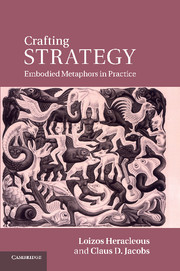Book contents
- Frontmatter
- Contents
- List of figures
- List of tables
- Preface
- Acknowledgments
- Vignette A BASF PerForm
- Vignette B UNICEF
- Vignette C Project Voltigo
- Vignette D Hephata Foundation
- Vignette E Privatbank IHAG Zürich AG
- Vignette F World Vision New Zealand
- 9 The process of strategizing through crafting embodied metaphors
- Glossary
- Index
- References
9 - The process of strategizing through crafting embodied metaphors
Published online by Cambridge University Press: 05 June 2011
- Frontmatter
- Contents
- List of figures
- List of tables
- Preface
- Acknowledgments
- Vignette A BASF PerForm
- Vignette B UNICEF
- Vignette C Project Voltigo
- Vignette D Hephata Foundation
- Vignette E Privatbank IHAG Zürich AG
- Vignette F World Vision New Zealand
- 9 The process of strategizing through crafting embodied metaphors
- Glossary
- Index
- References
Summary
This chapter aims at providing readers with some practical guidance to assess when it would be most appropriate to use embodied metaphors, as a synthetic, divergent intervention approach; and when other, more convergent or analytical intervention approaches would be most appropriate. Thus, we set out by discussing occasions within organizational life that lend themselves to be explored or supported by embodied metaphors more than others. Then, we describe the generic process of crafting embodied metaphors and provide some guiding principles based on our experience. We finally discuss the organizational context and enabling conditions for the most effective use of the approach, and outline what can meaningfully be expected from our approach, and what cannot.
When is it most appropriate to craft embodied metaphors?
Playing seriously may not always be the most appropriate choice in all stages of strategizing. Since this process helps to manifest differences and creative tensions, both through the crafting process as well as through the various constructions, it lends itself particularly well to stages in strategizing where novelty, difference and ambiguity are appreciated and can indeed be productive – for example, when agents need a way to help them see a strategic challenge in a different light and explore alternatives in an open-ended way.
- Type
- Chapter
- Information
- Crafting StrategyEmbodied Metaphors in Practice, pp. 209 - 224Publisher: Cambridge University PressPrint publication year: 2011



